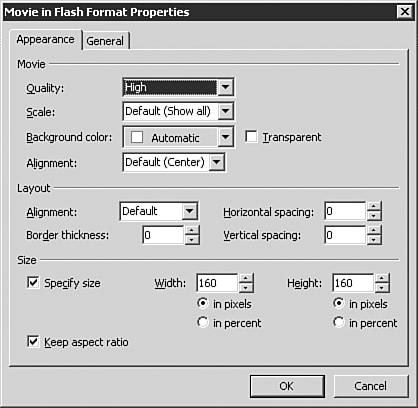Using Vector Formats
| In addition to the standard bitmap formats, several new vector formats are available, such as Flash and SVG. The Flash format, developed by Macromedia, requires a plug-in to work. Why would anyone want to use a graphics format that requires a plug-in? Vector graphics are represented by mathematical formulas and numbers. This makes their file sizes much smaller when compared to bitmap images. Animations are another area in which vector formats are a huge advantage. GIF animations require the space of several images shown one after another, but vector animations need to know only how the mathematically defined lines, curves, and colors change over time. This yields a dramatic size savings and can really open your Web presentations to some elaborate full-screen effects. NOTE You can import vector images, such as WMF, into FrontPage, but these get converted to a Web friendly graphic format when the Web page is saved. Make sure that you do the same if you create Word Art with FrontPage or use the FrontPage drawing tools. Macromedia FlashThe most popular vector format currently is Macromedia's Flash. The latest version offers advanced features such as music, sound effects, and interactivity. FrontPage supports the Flash format directly. After a Flash file is added to a Web page, several properties can be set. Figure 44.4 shows the Flash Properties dialog box. To access this dialog box, right-click the Flash object and select properties. Figure 44.4. FrontPage lets you change the properties of a Flash file.
SVGSVG stands for Scalable Vector Graphics. The SVG format is a vector-based format sponsored by the World Wide Web Consortium with broad industry support. SVG is based on XML, which enables the image definitions to be included as text within an HTML document. You also can control the image elements using a scripting language, such as JavaScript. Because SVG graphics are based on XML, FrontPage can accept SVG images, but the internal FrontPage browser cannot interpret or preview the graphics. Selecting the HTML tab at the bottom of the FrontPage window will let you view the SVG code. CAUTION Currently, only browsers with an SVG Viewing plug-in installed can view SVG files. One such plug-in can be found at the Adobe Web site: http://svg.frontpagelink.com. As a result, use this format with caution. |
EAN: 2147483647
Pages: 443

 For more information on inserting Flash files into your FrontPage Web site,
For more information on inserting Flash files into your FrontPage Web site,